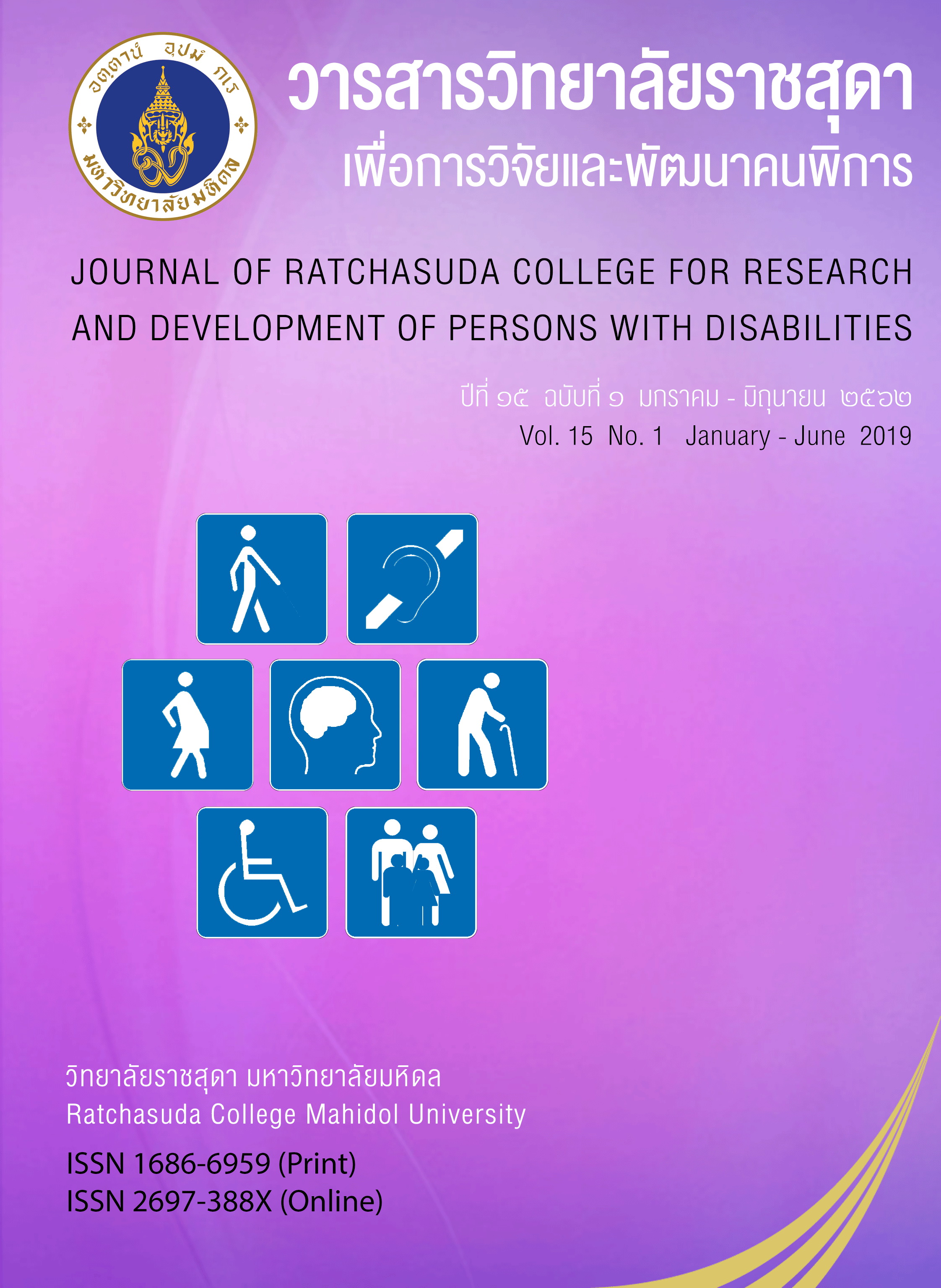ลักษณะงานและอาชีพที่เหมาะสมกับบุคคลกลุ่มอาการออทิสซึมวัยทำงาน
คำสำคัญ:
กลุ่มอาการออทิสซึมวัยทำงาน, ลักษณะงานและอาชีพที่เหมาะสมกับบุคคลกลุ่มอาการออทิสซึมยุทธศาสตร์, การประกอบอาชีพสำหรับบุคคลกลุ่มอาการออทิสซึมบทคัดย่อ
การเพิ่มขึ้นของคนในกลุ่มอาการออทิสซึม ซึ่งเป็นผู้มีความผิดปกติของพัฒนาการ 3 ด้าน คือ ด้านการสื่อสาร ด้านการเข้าสังคมและด้านพฤติกรรม ทำให้จำเป็นต้องจัดบริการและการช่วยเหลือต่างๆ การประกอบอาชีพเป็น การเพิ่มขึ้นของคนในกลุ่มอาการออทิสซึม ซึ่งเป็นผู้มีความผิดปกติของพัฒนาการ 3 ด้าน คือ ด้านการสื่อสาร ด้านการเข้าสังคมและด้านพฤติกรรม ทำให้จำเป็นต้องจัดบริการและการช่วยเหลือต่างๆ การประกอบอาชีพเป็นความจำเป็นอย่างหนึ่งสำหรับคนในกลุ่มนี้ โดยเฉพาะกลุ่มศักยภาพสูงที่มีความต้องการในการประกอบอาชีพและพบว่าการมีอาชีพของกลุ่มคนเหล่านี้มีมูลค่าต่อเศรษฐกิจอย่างมีนัยสำคัญ บทความนี้มีจุดประสงค์เพื่อทบทวนงานวิจัยและรวบรวมข้อมูลที่เกี่ยวข้องกับลักษณะอาชีพของผู้ที่มีภาวะออทิสซึมในวัยทำงาน และนำเสนอข้อมูลเกี่ยวกับลักษณะของบุคคลที่มีภาวะออทิสซึม สภาวะการทำงาน ลักษณะอาชีพที่เหมาะสม และยุทธศาสตร์ที่นำไปสู่ความสำเร็จในการประกอบอาชีพของคนกลุ่มอาการนี้ สภาวะการทำงานพบว่าคนกลุ่มนี้ไม่ได้รับการจ้างงานมากกว่าได้รับการจ้างงาน งานที่เหมาะกับคนกลุ่มนี้ควรเป็นงานที่ต้องใช้ความจำระยาวมากกว่าความจำระยะสั้น เนื่องจากคนกลุ่มนี้มีความจำระยะยาวดีและอาจดีกว่าคนปกติทั่วไป งานควรมีลักษณะเป็นรูปธรรมที่สามารถคิดเป็นภาพได้ ยุทธศาสตร์ที่ช่วยให้การประกอบอาชีพของคนกลุ่มนี้ประสบผลสำเร็จประกอบด้วย 1) การกำหนดตำแหน่งงาน 2) จัดที่ปรึกษาที่ดูแลให้ความช่วยเหลือและสอนงาน 3) การฝึกอบรมระหว่างการทำงาน 4) การปรับสถานที่ทำงาน และ 5) การสนับสนุนอย่างต่อเนื่อง
Downloads
เอกสารอ้างอิง
Center of Disease Control and Prevention. (2018). Prevalence and characteristics of autism spectrum disorder among 4-year-old children. Retrieved from https://www.cdc.gov/ncbddd/autism/articles.html
Chalongkraeun, R. (2016). 10 Organization-Private Sector turn to hire ASD. Retrieved 3/March/2019 from https://mgronline.com/qol/detail/9590000031166
Department of Empowerment of Persons with Disabilities. (2017). Ministry of Social Development and Human Security. Annual report on the disabilities in Thailand. Retrieved from https://drive.google.com/file/d/0B7zm DKP8VFLaTTNBbnh 5RGczUjg/view
Grandin, T. (1999). Choosing the right job for people with autism or asperger’s syndrome. Retrieved from https://www.indiana.edu/page/Choosing-the-Right-Job-for-People-with-Autism-or-Aspergers-Syndrome
Hendricks, D. (2010). Employment and adults with autism spectrum disorders: Challenges and strategies for success. Journal of Vocational Rehabilitation, 32, 125-134.
Hillier, A., Campbell, H., Mastriana, K., Izzo, M., Tucker, A., & Cherry, L. (2007). Two-year evaluation of a vocational support program for adults on the autism spectrum. Career Development
for Exceptional Individuals, 30 (1). 35-47.
Howlin, P., Alcock, J. & Burkin, C. (2005). An 8 year follow-up of a specialist supported employment service for high-ability adults with autism or asperger syndrome. The International Journal of Research & Practice, 9(5), 533-549.
Howlin, P., Jordan, R. R. & Evans, G. (1995). Distance education course in autism (Adults, Module 3, Unit 3), School of Education, Birmingham, UK: University of Birmingham.
Jarbrink, K., McCrone, P., Fombonne, E., Zanden, H., & Knapp, M., (2007). Cost-impact of young adults with high-functioning autistic spectrum disorder. Research in Developmental
Disabilities, 28, 94-104.
MGR online. (2016). 10 Organization-Private Sector turn to hire ASD. Retrieved 3/March/2019 from https://mgronline.com/qol/detail/9590000031166
Moxom, L., & Gates, D. (2001). Children with autism: Supporting the transition to adulthood. Education and Child Psychology, 18, 28-40.
National Organization on Disability. (2006). N.O.D./Harris Survey of Americans with Disabilities: Landmark survey finds pervasive disadvantages. Retrieved from http://w.w.w.nod.org/
content.cfm?id=15367.
Sanrattana, U., Chanpeng, P., Siriruk, P., & Sirinun, S. P. (2016). Current state, vocational needs of disabilities and case study of persons with autism spectrum disorder. Journal of Ratchasuda College for Research and Development of Persons with Disabilities, 12(15), 21-41.
Smith, D.D. (2004). Introduction to special education: Teaching in an age of opportunity. (5th ed.). Boston: Pearson Education, Inc.
Smith, M., Belcher, R. G., & Juhrs, P. D. (1995). A guide to successful employment for individuals with autism. USA: Paul H, Brookes Publishing.
Sriwongpanich, N. (2018). Only of 100 ASD in 18,220 ASD in Thailand has jobs with income. Retrieved 3/March/2019 from http://www.bangkokbiznews.com/news/detail/797549
Thailand. (2013). The Person with Disabilities Empowerment Act, (second amendment) B.E.2556. Government Gazette. Royal Decree 130 (Section 30 A), Bangkok: Thailand.
Triruangworawat, B. (2017). Research on gene of autism spectrum disorder and prevalence. Retrieved from https://www.dmh.go.th/news-dmh/view.asp?id=26705
United State Department of Education. (2005). Office of Special Education Program. Twenty-seventh annual report to congress on the implementation of individuals with disabilities education act, 2005. USA.
Wagner, M., Newman, L., Cameto, R., Garza, N., & Levine, P. (2005). After high school: A first look at the post-school experiences of youth with disabilities. A report from the national longitudinal transition study-2 (NLTS-2). Retrieved from https://eric.ed.gov/?id=ED494935
ดาวน์โหลด
เผยแพร่แล้ว
รูปแบบการอ้างอิง
ฉบับ
ประเภทบทความ
สัญญาอนุญาต
บทความที่ได้รับการตีพิมพ์เป็นลิขสิทธิ์ของวารสารสถาบันราชสุดาเพื่อการวิจัยและพัฒนาคนพิการ






